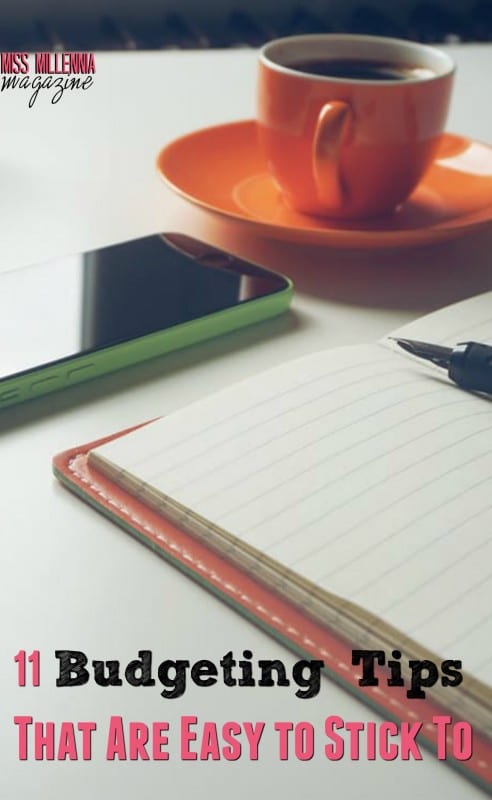11 Budgeting Tips That Are Easy to Stick To
I’m going to tell you something that you probably already know: saving money is hard. Like, really hard. Especially in this world where even a master’s degree and five years of experience doesn’t mean you’ll obtain an entry-level position. How exactly are we supposed to be saving money when we can’t even pay the bills?! Well, first things first: you’re going to need to budget.
***This article contains affiliate links, and we will be compensated for any purchase made by clicking on them. Thank you for supporting Miss Millennia Magazine!*
Why you need a budget
Laugh at me if you must but I seriously didn’t understand the need for a budget until just a year or two ago. And it’s not that I was just totally spoiled and unaware of the real world. In fact, all throughout high school and college, I had jobs, sometimes as many as three at once. But rather than budgeting, I would always just earn and spend, earn and spend. I had no idea where my money was going. I only knew that I was earning enough to spend and that was good enough for me.
But when I truly was “on my own” in grad school, I started seeing and understanding the need for a budget. Budgets help you understand where your money should be going and where it’s actually going. And if you’ve got bills to pay (so, all of us), that’s important information to know.
So, great. You know that you need a budget. But how exactly does one go about creating a budget? I’ve got you, boo! Check out my 11 budgeting tips:
1: Figure out your fixed and variable expenses
When you’re working on a budget, one of the very first steps you’re going to need to take is to figure out your fixed and variable expenses. A fixed expense is any outgoing money that is the same amount every month. Think along the lines of cell phone bills, Netflix account (because you’re paying for your own….right? Time to get off Mom and Dad’s account!), car payments, insurance, student loans, etc. These are the things that will be coming out of your account every month, no ifs ands or buts.

Then move onto your variable expenses. This is pretty much everything else. Variable expenses include things like groceries, gas, going out money, shopping money, etc. You can estimate on these amounts but don’t short-change yourself. If you’re a habitual online shopper, don’t tell yourself that you’ll only spend $20/month on shopping. That’s not realistic and you’ll start your budget off on the wrong foot.
Once you’ve got your fixed and variable expenses figured out, you can add them together to figure out how much money you’re putting out each month which will help you get a handle on your money.
2: The 50/30/20 method
You’ve probably seen this method floating around the interwebs. It’s a pretty simplistic approach but has a cult following for a reason: it’s easy and it works. For this method, you’re going to allot 50% of your take-home income to essential costs. Your essential costs definitely include your fixed expenses and probably some of your variable expenses as well (like gas money or grocery money). 50% might seem like a lot right off the bat but when you think about how many line items are included in “essentials,” it makes sense.
Next, 30% of your take-home income goes towards your personal or fun items. This is probably where a lot of your variable expenses come in. This also includes things like your Netflix account (since that’s a non-essential) or your alcohol money.
Finally, 20% of your take-home income goes straight to savings. And once it’s in your savings, don’t touch it. The 50/30/20 method is great for learning to live within your means.
3: The cash envelope method
The cash envelope system is another popular savings method that operates solely on cash. You could use this method exclusively for budgeting or use the 50/30/20 method and use the cash envelope system to allot your 30%. The basis of the cash envelope system says that you have an envelope for every category: one envelope for groceries, one for gas, one for eating out, one for entertainment, etc. You’ll need to do some math about how much money can be allocated to each category and once you have, you’ll take out cash and divide it amongst the envelopes. Once the cash in an envelope is gone, it’s gone.
I personally use this method for my fun money. I allocate X amount of money for eating out, alcohol, going to the movies, etc. If I blow all the cash in my “eating out” envelope by the 10th of the month, well, it looks like I’m not eating out for the rest of the month. This method requires a lot of self-control but is effective because it’s so tangible and visible.
4: Set a specific goal
It’s always helpful for me to have something specific to work towards. For example, right now I am trying to save $5,000 to move to Ireland. Maybe you want to save $7,000 for a down payment on a car or save $1,500 to buy an engagement ring. Or perhaps you don’t have a big purchase or a milestone to save for but you just want to have $20,000 in the bank. Whatever your reason or motivation might be, giving yourself a specific goal and revisiting your goal often will help you budget.
5: Save every $5 bill
Another raved-about internet method is saving every $5 bill you encounter. If you carry cash a lot, this method will make you rich in no time. Even if you don’t carry cash very often, it’s still fun. The whole point of this tactic is to simply keep a jar in your house and deposit every single $5 you receive into it. You could say that your $5 bill jar is dedicated to that really expensive pair of designer jeans or towards your next vacation. Similar to the cash envelope method, the $5 tactic is just a super visual way to save.

6: Comparison shop
Now is the part of the article where we start getting thrifty. Turn up your nose if you want but thrifty people are the ones coming out on top. One of the first ways to start being thrifty is to comparison shop. This means no more impulse buys! When you find something you want to buy, tell yourself you have to check out at least three competitors before buying. Chances are, you’ll find it cheaper somewhere else and save yourself some cash!
7: Never buy anything without a coupon
In the same vein as comparison shopping, never buy anything without a coupon or at least a discount. Obviously, you won’t find a coupon for absolutely everything in your grocery cart and that’s not really what I’m talking about. I mean things like clothes. Did you know that JCPenney.com always has a coupon on their website? Always. Many other stores are the same. If you’re out shopping for your next cute outfit, remember to hit up Google for coupons before you head to the register.
8: Shop clearance or off season
We’re getting thriftier as we go, can you tell? Yeah, you’ll save money using coupons but you’ll save even more money on clothes and shoes if you shop clearance sections or shop out-of-season clothes. One of the easiest ways to do this is to shop for spring and summer clothes in the fall and shop for fall and winter clothes in the spring. Stores put out-of-season clothes on clearance in the off season and you can catch some really good deals. I worked at JC Penney for six months and our entire stock of winter coats went on clearance for 75% off in February because the spring lines were already arriving. They flew off the racks but the lucky guys and gals who snapped them up got really good deals.

9: Go out on the cheap
When you sit down and figure out how much you spend on your variable expenses, chances are you’ll be shocked by how much you spend on going out. A couple of drinks at this bar and a pizza at that local joint downtown add up fast. One easy way to save money in this area is by using Groupon to find great deals on activities, food, and other services in your area. I’ve gotten everything from half-price movie tickets to 75% off bikini waxes on Groupon and have yet to be disappointed. You’ll save a lot of money and added bonus, you might discover your new favorite pizza place.
10: Take advantage of discounts
If you’re a student, teacher, military member, senior citizen, etc., there are some great discounts out there for you! Don’t be afraid to ask at places if they’ve got a discount for you. At Penney’s, for example, we have a military discount that not many people know about. But all you have to do is ask and we just punch it in for you! Slap that ID card out onto the counter and see how much money you can save.
11: Use free services
When I say free services, I mean for literally anything. Paying for a yoga class? Check out Yoga with Adriene on YouTube. Haircuts are too expensive? See if you can make a swap with someone on Simbi. There are so many free services out there. Chances are, you’re paying for something right now that you could be getting for free. A little research will go a long way here!
If you’ve stuck with me this far, congrats! You made it to the end! I’m not saying you need to employ every single tactic or method listed here but picking or choosing a couple of these budgeting tips can save you quite a bit of cash in the long run.
What other budgeting tips did I overlook? Leave them in the comments below so we can all get rich!
Resources: Groupon, Yoga with Adriene, Simbi








